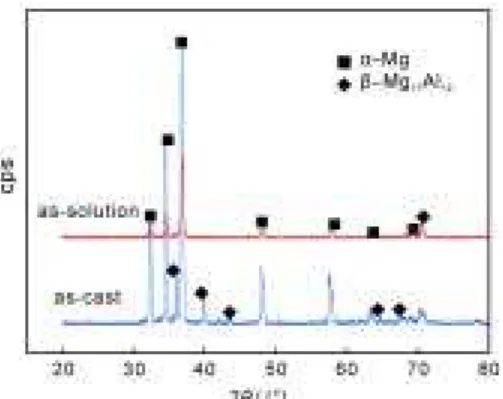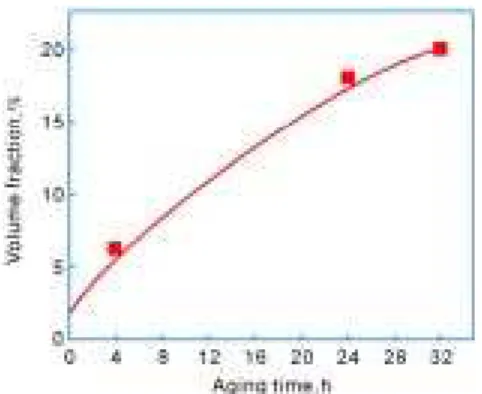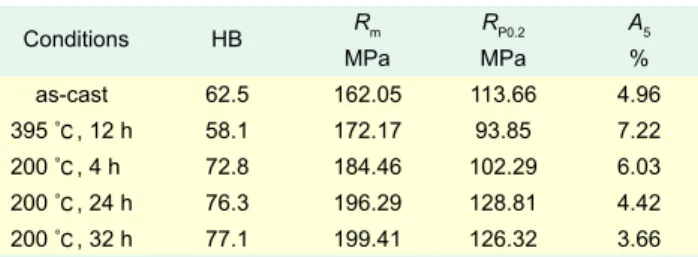296
CHINA FOUNDRY
Vol.4 No.4
Influence of aging modes on
microstructure and mechanical
properties of AZ80 magnesium alloy
*ZHANG Ju-mei1,2, JIANG Bai-ling1, WANG Zhi-hu1, YUAN Sen1, NAN Hong-qiang1, LUO Hong-bin1
(1. School of Materials Science and Engineering, Xi’an University of Technology, Xi’an 710048, China; 2. Department of Materials Science and Engineering; Xi’an University of Science & Technology, Xi’an 710054, China)
T
he development in light metal field is continuously pushing magnesium alloys into an important position in industrial applications for its high specific strength and specific stiffness, good castability, damping characteristic, machining and excellent electromagnetic shielding. So, more and more magnesium alloy structural components have been used in aviation, automobile and electron industries [1-4]. Due to the formation of large amountof brittle intermetallic β-Mg17Al12 phases [5] that are mainly
distributing along the α-Mg grain boundary continuously, the cast magnesium alloy with high Al content, such as AZ80 and AZ91, has the decreasing toughness and ductility [6]. In previous
researches, many researchers have focused their efforts on improving the performance of magnesium alloys through heat treatment, which are widely applied in industries. Many literature reviews about homogenizing or solution and aging heat treatment of Mg-Al alloys [7-9] have been published.
Therefore, the purpose of this present study was to discuss the influence of aging modes on the microstructure and mechanical properties of AZ80 magnesium alloy after solution treatment.
1 Experimental procedures
In the present study, the used AZ80 alloy billet with a diameter of 110 mm was produced by continuous casting process and supplied by ChongQing Magnesium Science & Technology Co. Ltd. The nominal chemical composition was shown in Table 1. Taking into account the consistency of samples, we took the samples from concentric circle region of the billet. In heat treatment trials, the samples for microstructure and tensile testing, based on industrial standard GB6397-86, were cut into cubes with the size of 10 mm10 mm10 mm and cylindrical bars
with φ 6 mm, respectively. The samples were then heat-treated at 395 close to the solution temperature for 12 h, water-cooling, then aged at 200 for time periods ranging from 4 h to 32 h.
The microstructural evolution and mechanical properties of AZ80 magnesium alloy after solution and aging treatment were studied by using OM, SEM, XRD as well as tensile and hardness testing. Microstructures of as-cast and heat-treated specimens were observed under optical microscope and scanning electron microscopy (SEM, JEOL-6700F). Microanalysis and determination of crystal structure of the phases in the alloys were carried out by X-ray diffraction (XRD, XRD-7000). Hardness of samples (HBS2.5/62.5/30) was tested by HB-3000. Tensile test was performed under the condition of ambient temperature on a HT-2402-100KN material test machine, at a strain rate of 1 mmmin-1. Three tensile specimens were tested for each of the
alloys and the average value was calculated.
Female, born in 1978, doctor candidate. Research interests: the strengthening and toughening processing technology for magnesium alloys.
E-mail: feiyue-zjm@163.com
Received: 2007-03-19; Accepted: 2007-09-17 *ZHANG Ju-mei
Abstract: The microstructure and mechanical properties of AZ80 magnesium alloy after solid solution and aging treatments were studied by using optical microscope (OM), X-ray diffraction (XRD), scanning electron microscopy (SEM) as well as tensile testing. The results indicated that β-Mg17Al12 phase was getting to distribute discontinuously along the grain boundary after treated at 395 ageing for 12 h followed by water-cooling, but it did not dissolve into
α-Mg completely. The residual β-Mg17Al12 phase distributed along the grain boundary and had block-like or island shapes. The size of α-Mg was getting to be coarsening but not significantly. The β-Mg17Al12 precipitates appeared in discontinuous and continuous patterns from supersaturated α-Mg solid solution after aged at 200. The precipitation
patterns were associated with the aging time essentially. The tensile strength and elongation of the alloy increased significantly but the hardness and yield strength decreased after solid solution treatment. However, with the prolonging of aging time, the hardness and strength of alloy increased while the ductility decreased.
297
Research & Development
November 20072 Results and discussion
2.1 Influence of solid solution treatment on
microstructure of AZ80 alloy
Figure 1 shows X-ray diffraction patterns of cast and as-solution AZ80 alloy. The XRD results reveal that the AZ80 alloy is composed of α-Mg matrix and β-Mg17Al12 phases. The α-Mg matrix also appears in AZ80 alloy after solid solution treatment at 395 for 12 h followed by water-cooling, while the peaks of
β-Mg17Al12 phase disappears significantly. The typical SEM
morphology of as-cast AZ80 alloy, as shown in Fig.2, indicates that most of the β-Mg17Al12 eutectic phases, owing to the non-equilibrium solidification, distributed along the grain boundary with block-like or island shapes, only the small amount of them formed within α-Mg matrix. The eutectic structure occurs in the grain boundary as the divorced eutectic. Figure 3 shows the OM images of AZ80 alloy treated at 395 for 12 h, water-cooling. Compared with the as-cast microstructure, the heat-treated grains grew bigger, but not enough. The main β-Mg17Al12 phase discontinuously distributed along the grain boundary and did not completely dissolve into α-Mg phase during solid solution treatment. The residual β-Mg17Al12 phase distributed along the
Table 1 Chemical composition of as-cast AZ80 magnesium alloy, wt-%
Al Zn Mn Si Fe Cu Ni Mg
7.8-9.2 0.2-08 0.15-0.5 0.01 0.01 0.05 0.005 Bal.
Fig.1 X-ray diffraction patterns of as-cast and as- solution AZ80 alloy
Fig.2 SEM morphology of as-cast AZ80 alloy
Fig.3 OM image of as-solution AZ80 alloy
grain boundary and had block-like or island shapes. Therefore, the results indicated that the β-Mg17Al12 phase, discontinuously distributed along the grain boundary, did not dissolve into α -Mg phase completely at 395 for 12 h. It could be possible to
obtain the homogeneous microstructure of α-Mg solid solution only by either increasing solution temperature or prolonging holding time.
2. 2 Influence of aging treatment on
microstructure of AZ80 alloy
XRD analysis was performed on selected specimens to identify the phases via alloy aged at 200 after solution treatment at 395 for 12 h, as shown in Fig. 4. The diffraction peak of β
-Mg17Al12 phase that had vanished after solution treatment reappeared after the aging treatment. It illuminates that the β -Mg17Al12 phase precipitated from oversaturated solid solution owing to aging treatment. The longer the aging time and the stronger the diffraction peak of β-Mg17Al12, that is to say, the amount of β-Mg17Al12 phase is prominent. The volume fraction ofβ-Mg17Al12 phase as a function of aging time is shown in Fig.5, in which the volume fraction at the starting point 0 belongs to the alloy after solution treatment. It can be seen from Fig.5 that the volume fraction of β-Mg17Al12 phase increases very quickly at the initial period of the aging treatment, but when the aging time prolonged to ~30 h, the increasing of the volume fraction evidently slows down. It is attributed to the fact that the degree of saturation of the as-solution alloy is big at the beginning of precipitating, and the activating force of precipitation is big too. So, the free energy for phase transformation gradually releases
298
CHINA FOUNDRY
Vol.4 No.4
exhaustedly, which causes the precipitation rate to slow down, and the amount of precipitate β-Mg17Al12 phase during the late stage of aging has no significant change. The microstructural transformation in Fig.6 also testifies the results.
Fig.5 Effect of ageing time on the βββββ phase
Many researchers [10] have indicated that the precipitation of
β-Mg17Al12 phase occurred as two forms, discontinuous and continuous. Normally, the two forms coexist, but usually the discontinuous precipitation separates out as the forerunner, and then carries on the continuous precipitation.
Figure 6 shows the SEM micrographs of AZ80 alloy aged at 200 for various periods, from which the coarse white β -Mg17Al12 particle can be still observed in the specimens after solution treatment (395, 12 h, water-cooling). After the aging treatment for 4 h, discontinuous precipitates preferentially form at the grain boundaries, as shown in Fig. 6(a). With the increasing of aging time, the discontinuous precipitation ceases, and the continuous precipitates formed in the remaining regions of the grain that are not occupied by discontinuous precipitates increases, as shown in Fig. 6(b, c). The size of β-Mg17Al12 precipitates in the aging alloys is smaller in comparison with that in the as-cast alloy, due to solution and secondary precipitate.
Discontinuous precipitates mainly locate at the grain boundaries due to the quite high energy caused by many dislocations and defects. The high energy is responsible for the nucleation and growth of β-Mg17Al12 phase. Therefore, the discontinuous precipitations dominate at the initial period of aging treatment. When the aging treatment prolongs to a certain time, the continuous precipitates begin to form and increased gradually, which restrict the nucleation and growth of discontinuous precipitate.
So, the β-Mg17Al12 phase precipitates in two different ways after aging treatment at 200, the continuous and discontinuous
ones, which can be identified from their morphologies. Fig. 6(d) shows the high magnification SEM micrograph of discontinuous precipitations at grain boundaries and continuous ones within the grains, as directed by the white arrow in Fig. 6(b). Obviously, the discontinuous precipitate phases distribute at the grain boundary approximately parallel, with the rod- or strip-like shape. In addition, there exists some obvious orientation relationship
Fig.6 SEM micrographs of AZ80 aged at 200 for various times (a) 4 h; (b) 24 h; (c) 32 h; (d) magnification of arrow at Fig.6(b), showing a large amount of lamellar discontinuous precipitation(D.P.)at grain boundaries and granular-shaped continuous precipitates(C.P.) in the matrix
299
Research & Development
November 20072.3 Effects of aging treatment on mechanical
properties of alloy
Table 2 listed the average values of Brinell hardness (HB), tensile strength (Rm), yield strength (RP0.2) and elongation (A5) for all of the specimens tested in the study. It can be seen that solid solution and aging treatments of the AZ80 alloy resulted in a significant influence on mechanical properties. Compared with as-cast AZ80 alloy, yield strength of the alloys with solid solution treatment remarkably decreased, while the tensile strength and ductility increased significantly. Namely, the yield strength of solid solution AZ80 is lower than that of as-cast AZ80, which is ascribed to the coarsening of β-Mg17Al12 phase distributed along the grain boundary and dissolved into α-Mg phase. The β -Mg17Al12 phase dissolved into α-Mg phase can cause a remarkable weakening of baffle for dislocation motion. However, the dissolution of brittle β-Mg17Al12 phase also resulted in the weakening of disseverment for α-Mg matrix. Therefore, the elongation and tensile strength obviously enhanced, even more, the average value of elongation and the ratio of tensile to yield (Rm/RP0.2) increase to 7.22% from 4.96%, 1.84 from 1.43 of as-cast, respectively. In addition, the solid solution treatment not only made the secondly strengthening β-Mg17Al12 phase disappeared, but also drove the solute atoms to dissolve into the matrix, resulting in a slightly decrease in the hardness of the alloy. When the as-solution specimens of the alloys were aging-treated at 200 for various period, the β-Mg17Al12 phase precipitated from the oversaturated solid solution of α-Mg. With prolonging the aging time, the amounts of β-Mg17Al12 phase discontinuously precipitated at the grain boundaries and continuously precipitated within the grain increased gradually. Moreover, the grain size of β-Mg17Al12 precipitates is relatively finer, compared with the β-Mg17Al12 phase of as-cast alloy, and morphology exhibits a biggish transformation. Accordingly, the hardness and tensile strength of the alloys increase obviously and their average values increased from 62.5 HB and 162.5 MPa of as-cast to 77.1 HB and 199.41 MPa aged at 200 for 32 h, respectively. However, the ductility index A5 of alloys decreased
remarkably with the prolonging of aging time, even the average value of elongation at 200 for 32 h is lower than that of as-cast AZ80 alloy. The reason can be attributed to the increasing restriction of dislocation motion from precipitate β-Mg17Al12 phase with the aging process, in which the dislocations are packed, leading to the stress accumulated large enough to cause micro-crack, as a result, the ductility of alloy decreases gradually.
Comparison with mechanical property data between various heat treatment modes, it can be suggested that the discontinuous precipitation of β-Mg17Al12 phase has more contribution to promote the mechanical properties of AZ80 magnesium alloy.
3 Conclusions
(1) The β-Mg17Al12 phase was getting to distribute along the grain boundary discontinuously after treated at 395 ageing
for 12 h followed by water-cooling. However, it did not completely dissolve into α-Mg phase. The residual β-Mg17Al12 phase distributed along the grain boundary and had block like or island shapes. The size of α-Mg was getting to be coarser but not significantly.
(2) The processes of β-Mg17Al12 phase precipitation aged at
200 include two patterns, continuous and discontinuous, which were associated with the aging time essentially.
(3) The tensile strength and elongation of the alloy increased remarkably but the hardness and yield strength decreased after solid solution treatment. However, with the prolonging of aging time, the hardness and strength of alloy increased while the ductility decreased.
References
[1] Mordike B L, Ebert T. Magnesium properties-applications-potential. Materials Science and Engineering, 2001, A302: 37-45.
[2] Gray J E, Luan B. Protective coatings on magnesium and its alloys - a critical review. Journal of Alloys and Compounds, 2002, 36: 88-113.
[3] Song G, Bowles A L, St John D H. Corrosion resistance of aged die-cast magnesium alloy AZ91D. Materials Science and Engineering, 2004, A366: 74-86.
[4] Baqhni I M, WU Yin-shun, LI Jiu-qing, et al. Mechanical properties and potential applications of magnesium alloys. Trans. Nonferrous Met. Soc. China, 2003, 13(6): 1253-1259. [5] Dahle A K, Lee Y C, Nave M D. Development of the as-cast
microstructure in magnesium-aluminum alloys. Journal of Light Metals, 2001, 1(1): 61-72.
[6] Cizek L, Greger M, Pawlica L. Study of selected properties of magnesium alloy AZ91 after heat treatment and forming. Journal of Materials Processing Technology, 2004, 157-158: 466-471. [7] HUANG Wei, LI Di. Effects of isothermal heat-treatment at 300 on microstructure and mechanical properties of AZ91D die cast magnesium alloy. Transaction of Materials and Heat Treatment,
2006, 27 (2): 37-41.
[8] GUO Qiang, YAN Hong-ge, CHEN Zhen-hua. Influence of homogenizing annealing process on microstructure and mechanical properties of as-cast AZ80 magnesium alloy. Heat Treatment of Metals, 2006, 31(7): 77-80. (in Chinese) [9] JIN Jun-bing, WANG Zhi-xiang, LIU Xue-feng. Effect of
homogenizing treatment on microstructures and mechanical properties of AZ91 magnesium alloy. ACTA Metallurgica Sinica,
2006, 42(10): 1014-1018.
[10] WANG Yue, WU Wei, LIU Zheng. Characteristic of non-continuous precipitated phase in AZ91HP. Journal of Shenyang University of Technology, 2000, 22(6): 465-470. (in Chinese) [11] Zhang M X, Kelly P M. Crystallography of Mg17Al12 Precipitation
in AZ91D alloy. Scripta Materialia, 2003, 48: 647-652. Table 2 Mechanical properties of alloys for age
treatment at 200
Conditions HB Rm RP0.2 A5
MPa MPa %
as-cast 62.5 162.05 113.66 4.96
395 , 12 h 58.1 172.17 93.85 7.22
200 , 4 h 72.8 184.46 102.29 6.03
200 , 24 h 76.3 196.29 128.81 4.42


